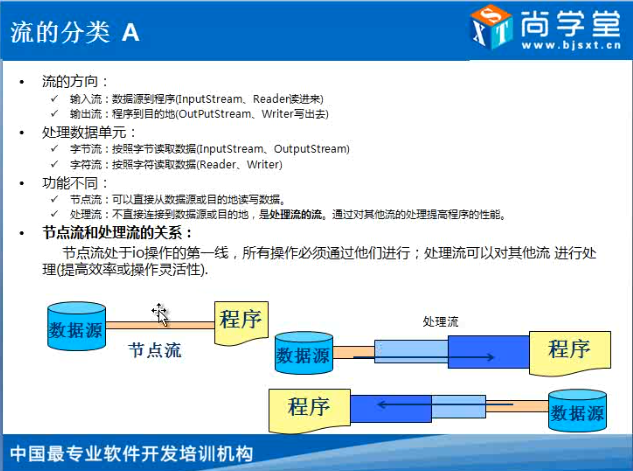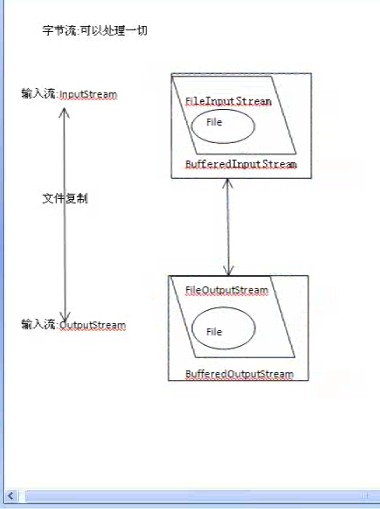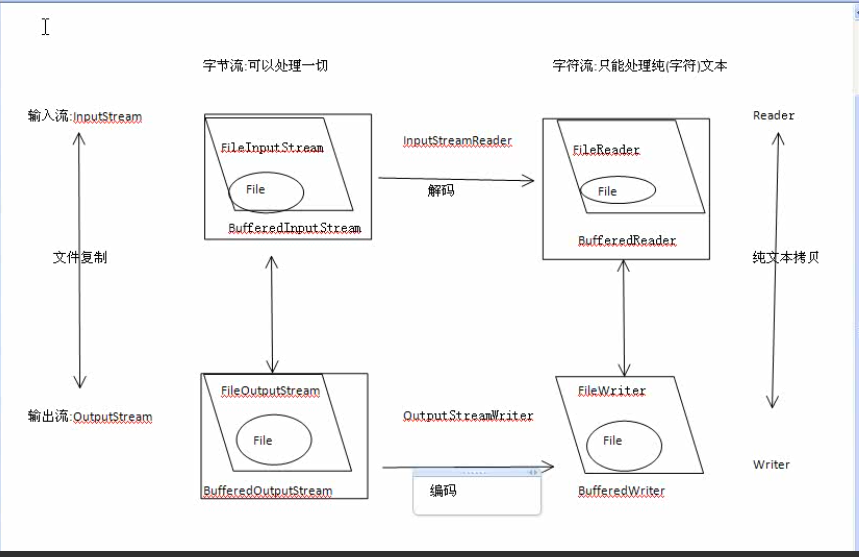java13 InputStream,Reader
2015-09-23 21:36
495 查看



流的方向:
1.输入流:数据源到程序(InputStream,Reader读进来)。
2.输出流:程序到目的地(OutPutStream,Writer写出来)。
处理数据单元:
字节流:按照字节读取数据(InputStream,OutPutStream)。
字符流:按照字符读取数据(Reader,Writer)
功能不同:
节点流:可以直接从数据源或目的地读写数据。
处理流:不直接连接到数据源或者目的地,是处理流的流,通过对其他流的处理提高程序的性能。
处理流:增强功能,提供性能,处理流在节点流之上。
一、缓冲流
1)针对字节有字节缓冲流
BufferedInputStream readLine()
BufferedOutPutStream
2)针对字符有字符缓冲流
BufferedReader newLine()
BufferedWriter
/**
* 字节流文件拷贝+缓冲流 ,以后使用建议加上缓冲流提高性能。
* 节点流上面包一层缓冲流。
*/
public class BufferedByteDemo {
public static void main(String[] args) {
}
/**
* 文件的拷贝
* @param 源文件路径
* @param 目录文件路径
* @throws FileNotFoundException,IOException
* @return
*/
public static void copyFile(String srcPath,String destPath) throws FileNotFoundException,IOException {
//1、建立联系 源(存在且为文件) +目的地(文件可以不存在)
File src =new File(srcPath);
File dest =new File(destPath);
if(! src.isFile()){ //不是文件或者为null
System.out.println("只能拷贝文件");
throw new IOException("只能拷贝文件");
}
//2、选择流,利用缓冲流提高性能,
InputStream is =new BufferedInputStream(new FileInputStream(src));
OutputStream os =new BufferedOutputStream( new FileOutputStream(dest));
//3、文件拷贝 循环+读取+写出
byte[] flush =new byte[1024];
int len =0;
//读取
while(-1!=(len=is.read(flush))){
//写出
os.write(flush, 0, len);
}
os.flush(); //强制刷出
//关闭流
os.close();
is.close();
}
}
/**
* 字符缓冲流 +新增方法(不能发生多态),字符流外面包一层缓冲流。
*/
public class BufferedCharDemo {
public static void main(String[] args) {
//创建源 仅限于 字符的纯文本
File src =new File("E:/xp/test/1.java");
File dest =new File("e:/xp/test/2.txt");
//选择流
BufferedReader reader =null;
BufferedWriter wr =null;
try {
reader =new BufferedReader(new FileReader(src));
wr =new BufferedWriter(new FileWriter(dest));
//读取操作
/*
char[] flush =new char[1024];
int len =0;
while(-1!=(len=reader.read(flush))){
wr.write(flush, 0, len);
}*/
//新增方法的操作
String line =null;
while(null!=(line=reader.readLine())){//line每次为一行内容
wr.write(line);
//wr.append("\r\n");
wr.newLine(); //换行符号
} wr.flush();//强制刷出,流关闭的时候也可以刷出,这里是养成良好的编程习惯。
} catch (FileNotFoundException e) {
e.printStackTrace();
System.out.println("源文件不存在");
} catch (IOException e) {
e.printStackTrace();
System.out.println("文件读取失败");
}finally{
try {
if (null != wr) {
wr.close();
}
} catch (Exception e2) {
}
try {
if (null != reader) {
reader.close();
}
} catch (Exception e2) {
}
}
}
}
二、转换流:字节流转为字符流,作用是为了处理乱码(编码集、解码集)。
1.编码与解码的概念:
解码:二进制(计算机只认二进制)解码成字符(人只懂字符)。
编码:字符编码成二进制。
文件都是二进制,读进程序(转成字符)就是解码,写出去就是编码(转成二进制写出到另一个文件)。
2.乱码问题:(解码的时候要知道原先的编码的字符集)
1)编码与解码字符集不统一。
2)字节缺少,长度丢失。
public class ConverDemo01 {
public static void main(String[] args) throws UnsupportedEncodingException {
test1();
//解码(把二进制的中国转成中国让你看得懂,默认gbk),byte->char
String str ="中国";
//编码,字符转字节,char->byte
byte[] data =str.getBytes();//data=[-42, -48, -71, -6]
//字节数不完整
System.out.println(new String(data,0,3));//String(byte[] bytes, int offset, int length)通过byte数组构建一个String,输出中?
}
/**
* 编码与解码字符集必须相同,否则乱码
* @throws UnsupportedEncodingException
*/
public static void test1() throws UnsupportedEncodingException{
//解码(把二进制的中国转成中国让你看得懂,默认gbk), byte -->char
String str ="中国"; //gbk
//编码,字符转字节, char -->byte
byte[] data =str.getBytes();//data=[-42, -48, -71, -6]
//编码与解码字符集同一
System.out.println(new String(data));//中国
data =str.getBytes("utf-8"); //设定编码字符集,data=[-28, -72, -83, -27, -101, -67]
//不同一出现乱码
System.out.println(new String(data));//涓浗
//编码
byte[] data2 = "中国".getBytes("utf-8");//data2=[-28, -72, -83, -27, -101, -67]
//解码
str=new String(data2,"utf-8");//中国
System.out.println(str);
}
}
/*字节————(解码)————>字符————(编码)————>字节
源文件(二进制文件,字节)————(解码)————>程序(在程序中为字符)————(编码)————>目标文件(二进制文件)*/
/**
* 转换流: 只能字节转为字符
* 1、输出流 OutputStreamWriter 编码,
* 2、输入流 InputStreamReader 解码,读取是解码(字节转为字符),ANSI就是GBK的编码方式。
* 确保源不能为乱码
*/
public class ConverDemo02 {
public static void main(String[] args) throws IOException {
/*BufferedReader br =new BufferedReader(
new FileReader(new File("E:/xp/test/Demo03.java"))
);//指定不了解码的字符集,所以只能底层使用字节流,因为字节给你可以解码,字符给你不能解码。*/
//指定解码字符集
BufferedReader br =new BufferedReader(//读进程序,1.java的文件的编码使用UTF-8编码的,所以这里的解码要UTF-8。
new InputStreamReader(//字符流和字节流不能直接操作,所以要用一个转换流。
new BufferedInputStream(
new FileInputStream(
new File("E:/xp/test/1.java"))),"UTF-8")
);
//写出文件 编码
BufferedWriter bw =new BufferedWriter(
new OutputStreamWriter(//用于编码的转换流
new BufferedOutputStream(
new FileOutputStream(new File("E:/xp/test/2.java")))));
String info =null;
while(null!=(info=br.readLine())){//读取源文件,每次读一行。
System.out.println(info);
bw.write(info);
bw.newLine();
}
bw.flush();
bw.close();
br.close();
}
}
其他流(数据在网络中传输都是通过流,不可能是传字符串):
一、字节数组(其他电脑的内存,服务器的内存):
输入流:ByteArrayInputStream read(byte[] byte int off,int len) + close()
输出流:ByteArrayOutputStream write(byte[] byte int off,int len)
/**
* 字节数组 节点流
* 数组的长度有限 ,数据量不会很大
*
* 文件内容不用太大
* 1、文件 --程序->字节数组
* 2、字节数组 --程序->文件
*/
public class ByteArrayDemo01 {
public static void main(String[] args) throws IOException {
read(write());
}
/**
* 输出流 操作与文件输出流 有些不同, 有新增方法,不能使用多态
* @throws IOException
*/
public static byte[] write() throws IOException{
//目的地,一个字节数组。
byte[] dest;
//选择流 不同点
ByteArrayOutputStream bos =new ByteArrayOutputStream();
//操作 写出
String msg ="操作与 文件输入流操作一致";
byte[] info =msg.getBytes();
bos.write(info, 0, info.length);//写到bos这个管道里去了
//获取数据
dest =bos.toByteArray();
//释放资源
bos.close();
return dest;
}
/**
* 输入流 操作与 文件输入流操作一致
* 读取字节数组(之前是读文件),数组的长度有限,数据量不会很大。
* @throws IOException
*/
public static void read(byte[] src) throws IOException{
//数据源传入
String msg = "输入流 操作与 文件输入流操作一致";
///byte[] src = msg.getBytes();
//选择流
InputStream is =new BufferedInputStream(
new ByteArrayInputStream(
src
)
);//跟外界没有联系就不会有检查异常
//操作
byte[] flush =new byte[1024];
int len =0;
while(-1!=(len=is.read(flush))){
System.out.println(new String(flush,0,len));
}
//释放资源
is.close();
}
}
/**
*1、文件 --通过程序->字节数组
*1)、文件输入流
* 字节数组输出流
*
* 2、字节数组 --通过程序->文件
* 1)、字节数组输入流
* 文件输出流
*/
public class ByteArrayDemo02 {
public static void main(String[] args) throws IOException {
byte[] data =getBytesFromFile("e:/xp/test/1.jpg");//文件 --通过程序->字节数组
toFileFromByteArray(data,"e:/xp/test/arr.jpg");//字节数组 --通过程序->文件
}
/**
* 2、字节数组 --程序->文件
*/
public static void toFileFromByteArray(byte[] src,String destPath) throws IOException{
//创建源src
//目的地
File dest=new File(destPath);
//选择流(不同的文件类型,选择的流不一样)
//字节数组输入流
InputStream is =new BufferedInputStream(new ByteArrayInputStream(src));
//文件输出流
OutputStream os =new BufferedOutputStream(new FileOutputStream(dest));
//操作 不断读取字节数组
byte[] flush =new byte[1];
int len =0;
while(-1!=(len =is.read(flush))){
//写出到文件中
os.write(flush, 0, len);
}
os.flush();
//释放资源
os.close();
is.close();
}
/**
* 1、文件 --程序->字节数组
*/
public static byte[] getBytesFromFile(String srcPath) throws IOException{
//创建文件源
File src =new File(srcPath);
//创建字节数组目的地
byte[] dest =null;
//选择流
//文件输入流
InputStream is =new BufferedInputStream(new FileInputStream(src));
//字节数组输出流 不能使用多态
ByteArrayOutputStream bos =new ByteArrayOutputStream();
//操作 不断读取文件 写出到字节数组流中
byte[] flush =new byte[1024];
int len =0;
while(-1!=(len =is.read(flush))){
//写出到字节数组流中
bos.write(flush, 0, len);
}
bos.flush();//输出流都要flush一下
//获取数据
dest =bos.toByteArray();
bos.close();
is.close();
return dest;
}
}
其他流
二、处理流:
1.处理基本类型+字符串(保留数据和类型),是处理流就要借助于节点流(把东西存到哪个地方去),
输入流:DataInputStream(看到InputStream就要字节流不能用字符流) readXxx
输出流:DataOutputStream writeXxx
/**
* 数据类型(类型只能是基本类型+String)处理流
* 1、输入流 DataInputStream readXxx()
* 2、输出流 DataOutputStream writeXxx()
* 新增方法不能使用多态
* java.io.EOFException :没有读取到相关的内容
*/
public class DataDemo01 {
public static void main(String[] args) {
try {
write("e:/xp/test/data.txt");
//read("e:/xp/test/arr.txt"); //非法内容
read("e:/xp/test/data.txt");
} catch (IOException e) {
e.printStackTrace();
}
}
/**
* 从文件读取数据+类型
* @throws IOException
*/
public static void read(String destPath) throws IOException{
//创建源
File src =new File(destPath);
//选择流
DataInputStream dis =new DataInputStream(
new BufferedInputStream(
new FileInputStream(src)
)
);
//操作 读取的顺序与写出一致 必须存在才能读取
//读取的顺序不一致,数据输出会存在问题
long num2 =dis.readLong();
double num1 =dis.readDouble();
String str =dis.readUTF();
dis.close();
System.out.println(num2+"-->"+str);
}
/**
* 数据+类型输出到文件
* @throws IOException
*/
public static void write(String destPath) throws IOException{
double point =2.5;
long num=100L;
String str ="数据类型";
//创建源
File dest =new File(destPath);
//选择流 DataOutputStream
DataOutputStream dos =new DataOutputStream(
new BufferedOutputStream(//OutputStream的子类
new FileOutputStream(dest)
)
);
//操作 写出的顺序 为读取准备,写入到文件data.txt
dos.writeDouble(point);
dos.writeLong(num);
dos.writeUTF(str);
dos.flush();
//释放资源
dos.close();
}
}
/**
* 数据类型(基本+String)处理流
* 1、输入流 DataInputStream readXxx()
* 2、输出流 DataOutputStream writeXxx()
* 新增方法不能使用多态
* java.io.EOFException :没有读取到相关的内容
*/
public class DataDemo02 {
public static void main(String[] args) {
try {
byte[] data=write();
read(data);
System.out.println(data.length);
} catch (IOException e) {
e.printStackTrace();
}
}
/**
* 从字节数组读取数据+类型
* @throws IOException
*/
public static void read(byte[] src) throws IOException{
//字节数组,选择流用字节数组输入流
DataInputStream dis =new DataInputStream(
new BufferedInputStream(
new ByteArrayInputStream(src)
));
//操作 读取的顺序与写出一致 必须存在才能读取
double num1 =dis.readDouble();
long num2 =dis.readLong();
String str =dis.readUTF();
dis.close();
System.out.println(num1+"-->"+num2+"-->"+str);
}
/**
* 数据+类型输出到字节数组中,输出到字节数组中用ByteArrayOutputStream。
* @throws IOException
*/
public static byte[] write() throws IOException{
//目标数组
byte[] dest =null;
double point =2.5;
long num=100L;
String str ="数据类型";
//选择流 ByteArrayOutputStream DataOutputStream
ByteArrayOutputStream bos =new ByteArrayOutputStream();
DataOutputStream dos =new DataOutputStream(
new BufferedOutputStream(
bos
)
);
//操作 写出的顺序 为读取准备
dos.writeDouble(point);
dos.writeLong(num);
dos.writeUTF(str);
dos.flush();
dest =bos.toByteArray();
//释放资源
dos.close();
return dest;//把double、long、String写入到字节数组dest中。
}
}
相关文章推荐
- HDU1026 Ignatius and the Princess I(java)
- java12 File类
- java11 Guava:谷歌开发的集合库
- 在Eclipse中添加Servlet-api.jar的方法
- eclipse控制台输出重定向到…
- java10 WeakHashMap
- java08 Set
- java07 map
- Android studio导入eclipse项目且不改变目录结构
- 认识理解Java中native方法
- java06
- java05
- 韩顺平 java 第十六讲 数组
- Spring AOP简述
- java04
- Java—— 随机抽取扑克牌游戏
- java解析json数据
- java03
- java的nio的缓冲区
- Java——点于圆的问题
